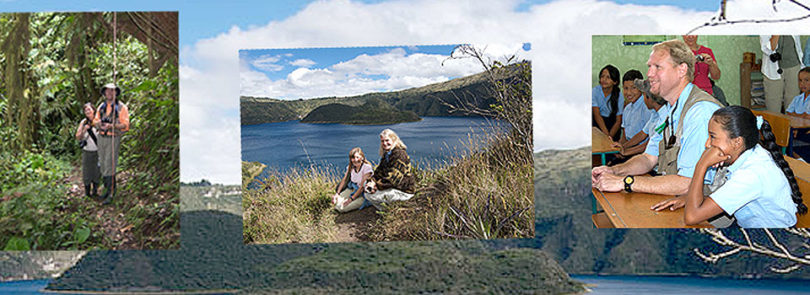High in the cloud forests of Ecuador, Georgia public school teachers listened and waited. Toucans, trogans and numerous species of hummingbirds flew through the canopy. In the damp, cool landscape, orchids and other plants filled the air with rich scents.
Welcome to a summer field course that attracted some 20 teachers from all over the state to lush sites in this South American country. Each day was packed with intensive study of issues relating to sustainable development. The course was sponsored by the Georgia Museum of Natural History, part of the University of Georgia’s Franklin College of Arts and Sciences, and the State Botanical Garden of Georgia.
The field school was based in the Maquipucuna Reserve, which has around 15,000 acres of primary and secondary forest and is located within Ecuador’s Choco Andean Bioregion, one of the world’s top-five biodiversity hot spots. The reserve incorporates habitats ranging from 4,000 to 9,000 feet above sea level.
“The reserve really has everything a field school like this needs,” said Carol Hoffman, education director of the museum and co-leader of the field school. “It’s a fascinating biological and ecological site, and a wonderful place to take teachers.”
Co-leader Anne Shenk, director of education at the Botanical Garden, agrees.
“The extent of the area’s biodiversity is evident everywhere,” she said. “For instance, every time you turn over a leaf you find an insect.”
But the beautiful cloud forest supports much more than insects and birds. Jaguars and spectacled bears prowl the reserve, too. And despite the fact that it’s almost directly on the equator, its altitude (some 4,000 feet) gives it a cool, wet climate.
The course, called The Global Naturalists Learning Community: Tropical Ecology of the Andes, developed from previous work that Hoffman and Shenk did with the Maquipucuna Foundation, including an international education project called “Our Shared Forests.” They designed the new field school and activities that teachers will take back to their classrooms to enhance scientific inquiry and help their students understand that global environmental issues affect them in Georgia.
The sheer richness of biodiversity in the Reserve is enough to startle anyone. Maquipucuna is home to a great variety of species, many of them endangered and/or endemic. There are around 2,000 plant species (more than 200 species of orchids), more than 349 bird species and more than 50 species of mammals.
“In addition to gaining a deeper understanding of the effects of a variety of land uses on the environment, course activities helped teachers gain a greater understanding of their students with family origins in Latin America,” explained Shenk.
Hoffman said the teachers also visited several towns and saw how homes, markets, schools, businesses and micro-enterprises operate and how they fit in with goals of sustainability. For instance, the town of Salinas has some 93 micro-enterprises, including chocolate and cheese production.
“Because of hunting and development pressures, some of the original species are gone, but so much remains, and there’s so much richness and diversity, that saving it is important, and every teacher understood that,” she said.
That perspective was tested often, however, not least on one trip when a giant cockroach made its appearance, along with numerous species of spiders and scorpions.








